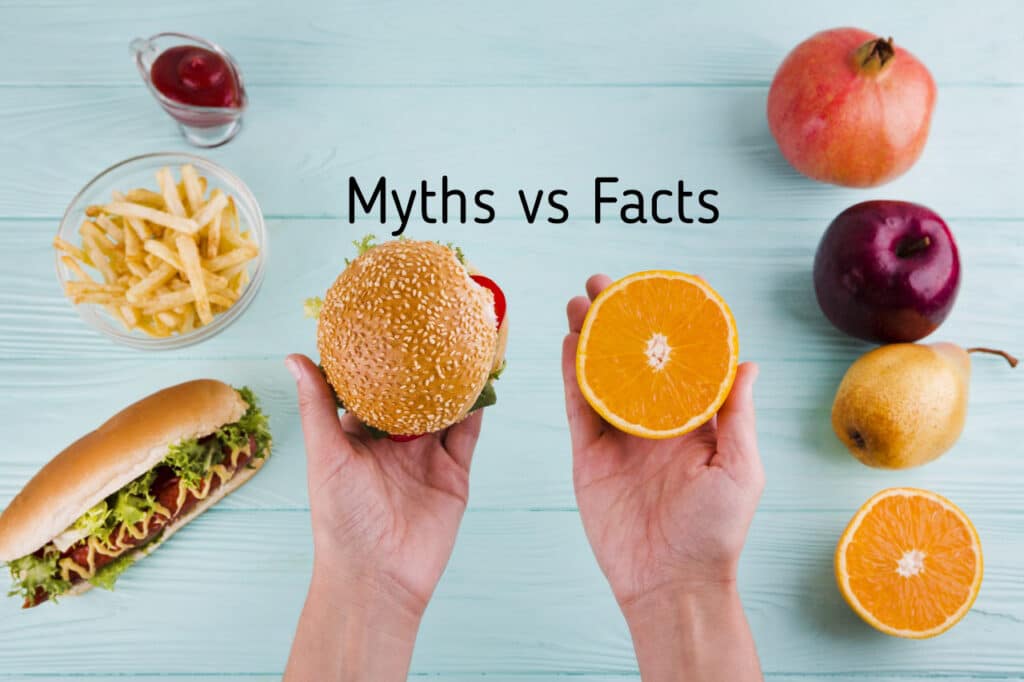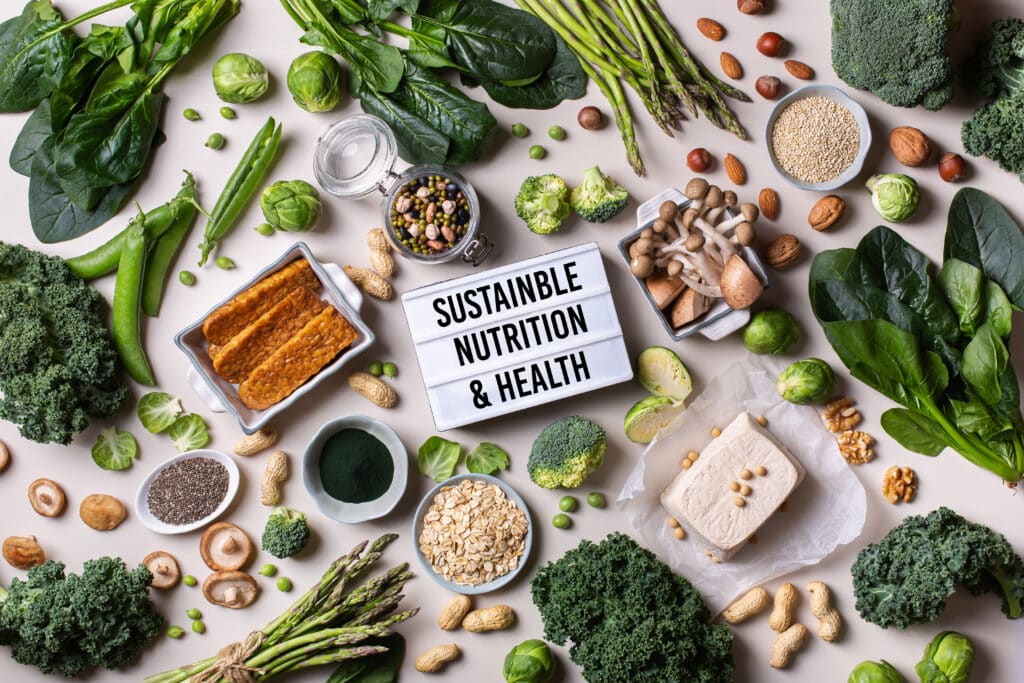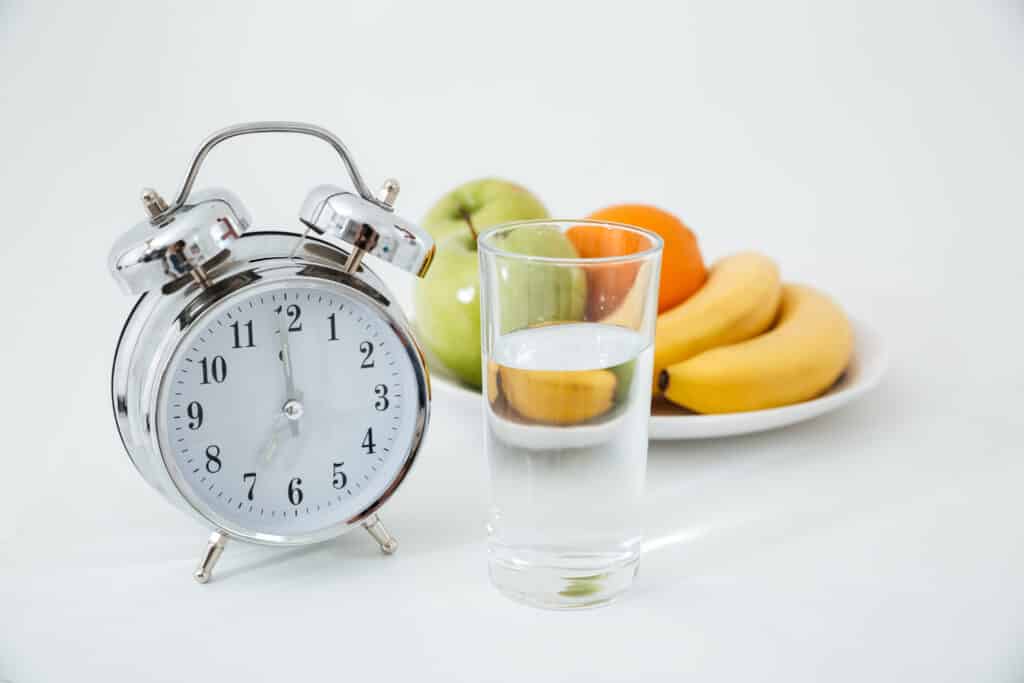Diet Myths: Food Facts vs. Fiction

The world of nutrition is buzzing with information, and amidst the noise, it’s easy to get tangled in the web of misleading diet myths. These misconceptions can hinder our journey towards optimal health and leave us feeling confused and frustrated. So, let’s take a stand against the misinformation and untangle the truth from the fiction! Myth #1: All Fats are Bad Fact: Healthy fats are essential for our body’s function! Unsaturated fats, found in avocado, nuts, and olive oil, play a crucial role in brain health, cholesterol balance, and even satiety. While saturated and trans fats should be limited, demonizing all fats is a recipe for nutritional imbalance. Myth #2: Detox Diets Cleanse Your Body Fact: Our bodies have built-in detoxifying systems – the liver and kidneys – that effectively eliminate waste products. Fad “detox” diets often lack scientific backing and can be restrictive and unsustainable. Remember, focusing on a balanced diet rich in fruits, vegetables, and whole grains are the natural and sustainable way to keep your body functioning at its best. Myth #3: Carbs are the Enemy of Weight Loss Fact: Complex carbohydrates like whole grains, fruits, and vegetables are important sources of energy and fiber, both crucial for feeling full and supporting gut health. While refined carbohydrates like white bread and sugary treats can contribute to weight gain, demonizing all carbs hinders their essential role in a healthy diet. Myth #4: Superfoods are Magical Weight Loss Solutions Fact: While certain foods are packed with nutrients, they are not magic bullets for weight loss. A sustainable approach to weight management requires a balanced diet, portion control, and regular physical activity. Focusing on an overall healthy eating pattern is key, rather than seeking quick fixes from individual superfoods. Myth #5: Skipping Meals Boosts Metabolism Fact: Skipping meals can actually backfire on your metabolism. It can lead to overeating later in the day, muscle loss, and even hinder weight loss efforts. Eating regular meals and snacks throughout the day keeps your metabolism running smoothly and provides your body with the fuel it needs to function optimally. Remember: –Always seek information from reputable sources like registered dietitians, credible health organizations, and peer-reviewed research. –Consult a healthcare professional for personalized dietary advice, especially if you have any underlying health conditions. –Focus on building a positive relationship with food that emphasizes balance, variety, and mindful eating. –Don’t fall prey to quick fixes or fad diets. Sustainable, healthy habits are the cornerstone of long-term health and well-being. By equipping yourselves with knowledge and staying informed, you can navigate the often-confusing world of nutrition and make informed choices about our health. With Healthylicious you choose evidence over hype, and fuel your bodies with the truth!
5 Key Elements of BMR and BMI Calculations: Unlocking Vital Metrics

Knowing your Basal Metabolic Rate (BMR) and Body Mass Index (BMI) is really important for understanding and taking care of your health. These calculations provide valuable insights that help you make smart decisions about your well-being. Let’s break down 5 key points that simplify the process of figuring out your BMR and BMI. BMR: The Foundation of Energy Expenditure Basal Metabolic Rate (BMR) represents the calories the body requires at rest to maintain vital functions. Factors influencing BMR include age, gender, weight, height, and body composition. Precisely calculating BMR offers a baseline for managing caloric intake and designing effective nutrition plans. BMI: A Measure of Body Composition Body Mass Index (BMI) quantifies an individual’s body fat based on height and weight. While BMI offers a general indication of health status, it might not account for muscle mass or distribution of body fat, warranting cautious interpretation. If your BMI is <18.5, it falls within the underweight range. If your BMI is 18.5 to <25, it falls within the healthy weight range. If your BMI is 25.0 to <30, it falls within the overweight range. If your BMI is 30.0 or higher, it falls within the obesity range. Interpreting BMI Categories BMI classifications categorize individuals into underweight, normal weight, overweight, or obese based on calculated values. However, it’s imperative to note that BMI alone might not accurately reflect an individual’s health or fitness level due to its limited consideration of other factors. Precision in Measurements Accurate measurements of weight, height, and body composition are critical for reliable BMR and BMI calculations. Utilizing standardized tools and employing consistent measurement techniques enhance the precision of these assessments. General Health Assessment While BMR and BMI calculations provide valuable insights, they should be viewed as components within a broader health assessment framework. Considering additional factors like waist circumference, body composition analysis, and overall lifestyle habits offers a more comprehensive understanding of individual health. Conclusion: Harnessing Insights for Holistic Wellness Mastering the calculation intricacies of BMR and BMI equips individuals with valuable tools for managing health and fitness. These metrics offer essential insights, serving as starting points for tailored nutrition and fitness plans. However, acknowledging their limitations and complementing them with broader health assessments ensures a holistic approach towards personal wellness. By embracing a comprehensive understanding of these calculations, individuals navigate their health journey with informed decisions, Calculate now your BMR and BMI as crucial indicators with Healthylicious for a broader context of overall well-being and fitness aspirations.
Controlling Sugar: 10 Tips to Lower Your Daily Intake

Sugar, while tasty, can sneak into our diets and affect our health. Here’s a detailed guide with easy steps to help you cut down on sugar: Decode Labels: When you read food labels, pay attention to the “sugars” section. Look for various names that signal added sugars, like sucrose, high-fructose corn syrup, or words ending in ‘-ose’ (like glucose or fructose). Choose Whole Foods: Favor whole foods over processed ones. Fresh fruits, veggies, whole grains, and lean proteins contain natural sugars along with vitamins, minerals, and fiber. They’re healthier choices compared to processed foods with added sugars. Rethink Your Drinks: Go instead for water, herbal teas, or infused water with natural flavors instead of sugary beverages like soda or sweetened juices. These alternatives hydrate without adding extra sugar. Smart Snacking: Select snacks that offer protein, healthy fats, and fiber. Nuts, Greek yogurt, or veggies with hummus make satisfying snacks that don’t spike sugar levels. Mind the Condiments: Be mindful of condiments and sauces as they often contain hidden sugars. Choose low-sugar options or try making your own to control sugar content. Manage Desserts Wisely: Moderation is key with sweet treats. Enjoy smaller portions or explore healthier dessert alternatives like fresh fruit to satisfy your sweet tooth. Home-Cooked Wins: Preparing meals at home gives you better control over sugar content. This way, you can reduce added sugars commonly found in restaurant or packaged foods. Sweeteners Selection: Limit your intake of artificial sweeteners and consider using natural alternatives like stevia or monk fruit sparingly if you need a sweet touch. Portion Control: Indulging in smaller portions of sugary treats can help curb cravings without overloading on sugar. Gradual Shifts for Long-Term Success: Making small but consistent changes to your diet over time allows your taste buds to adjust gradually. This method helps you adapt to less sugar without feeling deprived. Healthylicious will help you Implementing these practical steps into your routine gradually to significantly reduce your overall sugar intake, which contribute to a healthier diet and lifestyle in the long run.
2024’s Health Trends in Nutrition: Your Healthy Innovative Journey

As we enter 2024, significant changes are underway in the world of health and nutrition, driven by technological advancements, shifting consumer behaviors, and a greater emphasis on overall well-being. This blog explores the upcoming health trends shaping nutrition and how Healthylicious adapts to these changes, prioritizing optimal health and wellness. Holistic Wellness Focus: In 2024, people are seeking well-rounded health solutions surrounding physical, mental, and emotional aspects. Healthylicious responds by creating meal plans packed with functional foods and adaptogens, chosen specifically to improve mental clarity, manage stress, and promote emotional balance. Customization through Technology: Advanced technology like AI and data analytics is transforming nutritional guidance. Consumers now desire personalized nutrition plans based on genetics, metabolism, and lifestyle. Healthylicious pioneers this trend, using cutting-edge algorithms to craft personalized meal plans aligned with individual health goals. Implement Sustainable Choices: Environmental consciousness is influencing dietary preferences, with a focus on eco-friendly practices and ethical ingredients. Healthylicious takes a proactive stance by partnering with local eco-conscious suppliers, promoting regenerative agriculture, and introducing innovative plant-based options that reduce environmental impact while delivering great taste and nutrition. Integration of Health and Technology: Technology like wearable devices and health apps plays a major role in monitoring and enhancing nutrition and wellness in 2024. Healthylicious seamlessly integrates with this tech evolution, allowing customers to sync health data for personalized dietary insights and recommendations based on their evolving health metrics. Healthylicious remains at the forefront of these health trends, anticipating and embracing changes in consumer demands. By leveraging technology, tailoring nutritional plans, promoting sustainability, and integrating health-tech solutions, Healthylicious remains committed to offering innovative, personalized, and sustainable nutritional solutions in sync with the evolving wellness landscape of 2024.
Festive Feasts Cravings: Healthy Eating Tips for the Holidays!

In recent years, the gluten-free diet has surged in popularity, becoming a dominant trend among health-conscious individuals. While some embrace it for health reasons, others follow it as a lifestyle choice or due to perceived health benefits. However, like any dietary trend, the gluten-free diet presents both advantages and considerations that warrant exploration. The Rise of the Gluten-Free Trend The gluten-free diet trend has gained momentum, with many touting its potential health benefits, including improved digestion, increased energy, and weight management. This surge in popularity has led to an influx of gluten-free products in supermarkets and restaurants. Advantages Beneficial for Certain Conditions: For individuals with celiac disease, wheat allergy, or non-celiac gluten sensitivity, a gluten-free diet is essential to manage symptoms and prevent health complications. Focus on Whole Foods: Embracing a gluten-free diet often involves consuming more whole foods like fruits, vegetables, legumes, and gluten-free grains, promoting a nutrient-rich diet. Awareness of Food Choices: Following a gluten-free diet encourages individuals to be more mindful of food labels and ingredients, promoting awareness of dietary choices. Considerations Nutritional Imbalance: Eliminating gluten-containing grains may lead to a reduction in fiber, B vitamins, and other essential nutrients found in these grains, potentially causing nutritional deficiencies. Processed Gluten-Free Products: Many gluten-free alternatives are heavily processed and might contain high levels of sugar, unhealthy fats, and additives to mimic texture or taste, potentially being less healthy than their gluten-containing counterparts. Social and Practical Challenges: Following a strict gluten-free diet can pose social challenges in social gatherings or while dining out, limiting food choices and creating potential feelings of exclusion or inconvenience. The Importance of Individual Needs Determining whether a gluten-free diet is suitable requires consideration of individual health conditions, preferences, and lifestyle factors. For those with gluten-related disorders, eliminating gluten is non-negotiable for health management. However, for others without these conditions, the decision to adopt a gluten-free diet should involve careful consideration and professional guidance. Gluten-Free Labels Facts The “gluten-free” label on food makes us feel confident about what we’re eating, especially if we’re sensitive to gluten. But it doesn’t always tell the whole story. Foods labeled this way might still have tiny bits of gluten because they’re made in places that also use gluten. Certifications help make sure foods are really gluten-free, but it’s crucial to check the small details on labels, like “made where they handle wheat,” which could mean there’s a small risk of finding some gluten. Understanding these details helps us pick the right foods, paying attention to labels and extra info for a shopping trip that fits our gluten-free lifestyle and keeps us feeling good about our choices. Top of Form Conclusion: Balancing Health and Lifestyle Choices The gluten-free diet trend has undeniably shaped dietary habits and product availability, offering benefits for some while presenting challenges for others. Understanding its impact, potential advantages, and drawbacks is essential for making informed decisions about dietary choices. In the pursuit of a balanced and healthy lifestyle, it’s crucial to weigh the pros and cons of the gluten-free diet, considering individual health needs and ensuring that dietary choices align with personal health goals and well-being. Consulting with healthcare professionals or registered dietitians can provide valuable guidance in making dietary decisions tailored to individual needs. So that Healthylicious is your perfect guide!
The Gluten-Free Diet Trend: Advantages & Considerations

In recent years, the gluten-free diet has surged in popularity, becoming a dominant trend among health-conscious individuals. While some embrace it for health reasons, others follow it as a lifestyle choice or due to perceived health benefits. However, like any dietary trend, the gluten-free diet presents both advantages and considerations that warrant exploration. The Rise of the Gluten-Free Trend The gluten-free diet trend has gained momentum, with many touting its potential health benefits, including improved digestion, increased energy, and weight management. This surge in popularity has led to an influx of gluten-free products in supermarkets and restaurants. Advantages Beneficial for Certain Conditions: For individuals with celiac disease, wheat allergy, or non-celiac gluten sensitivity, a gluten-free diet is essential to manage symptoms and prevent health complications. Focus on Whole Foods: Embracing a gluten-free diet often involves consuming more whole foods like fruits, vegetables, legumes, and gluten-free grains, promoting a nutrient-rich diet. Awareness of Food Choices: Following a gluten-free diet encourages individuals to be more mindful of food labels and ingredients, promoting awareness of dietary choices. Considerations Nutritional Imbalance: Eliminating gluten-containing grains may lead to a reduction in fiber, B vitamins, and other essential nutrients found in these grains, potentially causing nutritional deficiencies. Processed Gluten-Free Products: Many gluten-free alternatives are heavily processed and might contain high levels of sugar, unhealthy fats, and additives to mimic texture or taste, potentially being less healthy than their gluten-containing counterparts. Social and Practical Challenges: Following a strict gluten-free diet can pose social challenges in social gatherings or while dining out, limiting food choices and creating potential feelings of exclusion or inconvenience. The Importance of Individual Needs Determining whether a gluten-free diet is suitable requires consideration of individual health conditions, preferences, and lifestyle factors. For those with gluten-related disorders, eliminating gluten is non-negotiable for health management. However, for others without these conditions, the decision to adopt a gluten-free diet should involve careful consideration and professional guidance. Gluten-Free Labels Facts The “gluten-free” label on food makes us feel confident about what we’re eating, especially if we’re sensitive to gluten. But it doesn’t always tell the whole story. Foods labeled this way might still have tiny bits of gluten because they’re made in places that also use gluten. Certifications help make sure foods are really gluten-free, but it’s crucial to check the small details on labels, like “made where they handle wheat,” which could mean there’s a small risk of finding some gluten. Understanding these details helps us pick the right foods, paying attention to labels and extra info for a shopping trip that fits our gluten-free lifestyle and keeps us feeling good about our choices. Top of Form Conclusion: Balancing Health and Lifestyle Choices The gluten-free diet trend has undeniably shaped dietary habits and product availability, offering benefits for some while presenting challenges for others. Understanding its impact, potential advantages, and drawbacks is essential for making informed decisions about dietary choices. In the pursuit of a balanced and healthy lifestyle, it’s crucial to weigh the pros and cons of the gluten-free diet, considering individual health needs and ensuring that dietary choices align with personal health goals and well-being. Consulting with healthcare professionals or registered dietitians can provide valuable guidance in making dietary decisions tailored to individual needs. So that Healthylicious is your perfect guide!
Eating Well, Living Well: How Sustainable Nutrition Boosts Your Health

In an era where what we eat profoundly impacts not just our own well-being but also the health of the planet, the spotlight has shifted to sustainable nutrition. This increasing concept extends far beyond mere dietary choices; it’s a conscious lifestyle shift that embraces eco-friendly diets and emphasizes the intimate connection between our plates and the environment. Nourishing the Earth, Nourishing Ourselves Sustainable nutrition isn’t solely about the food on our plates; it’s about understanding the journey food takes from farm to fork. It’s recognizing the impact of our dietary choices on the planet’s health and its ability to sustain life. Through mindful consumption and support for sustainable food production practices, we become stewards of both our personal health and the environment. A Menu for the Planet and Well-being Studies increasingly suggest that eco-conscious eating isn’t just a boon for the Earth; it also holds immense benefits for personal health. Embracing plant-based diets, reducing food waste, and supporting local, seasonal produce not only reduce our carbon footprint but also contribute to improved health outcomes. These diets, rich in diverse fruits, vegetables, and whole grains, are associated with lower risks of chronic diseases and enhanced well-being. Reimagining Food Systems for a Sustainable Future As we traverse this landscape, it becomes crucial to explore the intricate tapestry of sustainable food production. From regenerative agriculture to embracing circular economy principles, innovative practices are reshaping our food systems. By understanding and promoting these methods, we not only preserve biodiversity and natural resources but also foster healthier, more resilient food supplies. The Personal and Planetary Impact Choosing sustainable nutrition isn’t merely a personal choice—it’s a collective responsibility. Each mindful decision we make reverberates through the food chain, impacting ecosystems, local communities, and future generations. By aligning our dietary choices with environmentally conscious practices, we forge a path towards a healthier, more sustainable world for all. Conclusion: The synergy between sustainable nutrition and personal health presents an opportunity for individuals to become catalysts for change. By educating ourselves, making informed choices, and advocating for sustainable food systems, we not only nourish our bodies but also contribute to a harmonious relationship between humanity and the planet. In the journey toward sustainable nutrition, we discover that our plates are not just a canvas for nourishment but a canvas for change—a canvas that, when painted with mindful choices, can create a healthier, more sustainable world for generations to come. Don’t hesitate to look after your health with Healtylicious!
Office Wellness: 7 Hacks for Active Energy and Healthy Eating

For full-time employees immersed in the demands of the corporate world, maintaining a healthy lifestyle can be a challenge. Long hours at the desk, tight deadlines, and the ever-present temptation of office snacks can take a toll on well-being. In this blog, we’ll explore seven key tips on how to stay active during the day and complement it with nourishing, healthy food choices. Desk exercise for Energy Boosts: Combat the sedentary nature of office life by incorporating desk exercises into your routine. Simple stretches, leg lifts, or seated twists can be done discreetly at your desk, promoting blood circulation and providing a quick energy boost. Take Micro-Breaks for Movement: Set reminders to take short breaks throughout the day. Use these moments to stand, stretch, or take a brief walk around the office. These micro-breaks not only help alleviate physical stiffness but also refresh your mind for improved focus. Lunchtime Workouts or Walks: Maximize your lunch break by incorporating physical activity. Whether it’s a quick workout session, a brisk walk outside, or a yoga class, dedicating even a portion of your lunchtime to movement can make a significant impact on your overall well-being. Staircase Stints for Cardio: Opt for the stairs instead of the elevator whenever possible. Climbing stairs provides an excellent cardiovascular workout and engages various muscle groups. Challenge yourself to take the stairs and watch your fitness levels soar. Desk Snacking, but Make It Healthy: Snacking at the desk is inevitable, but the key is to make mindful choices. Stock your desk drawer with healthy options like nuts, seeds, fresh fruit, or yogurt. Avoid the temptation of sugary snacks and opt for nutrient-dense choices to keep your energy levels stable. Hydration Habits: Stay hydrated throughout the day by keeping a water bottle at your desk. Proper hydration not only supports overall health but also helps stave off mindless snacking. Opt for water over sugary drinks for a refreshing and calorie-free choice. Meal Prep Mastery: Take control of your nutrition by planning and preparing healthy meals for the workweek. Set aside time during the weekend to batch cook nutritious dishes that can be easily reheated at work. This ensures you have wholesome, homemade options readily available, reducing the temptation to grab unhealthy takeout. As a whole, thriving in a full-time job doesn’t mean compromising on your health. By incorporating these seven tips for staying active and complementing them with mindful eating, you can create a holistic approach to well-being. Remember, small, consistent changes can lead to significant improvements in your energy levels, focus, and overall happiness. Embrace the balance of movement and nourishment, and watch as your workdays become not only productive but also pillars of a healthy, fulfilling lifestyle with us now!!
Balancing Calorie Counting and Depression: Fine Line Between Health and Mental Well-being

Counting calories has long been a popular approach to managing one’s weight and promoting overall health. While it can be an effective tool for weight management, it’s essential to understand the potential impact of calorie counting on mental health, particularly in the context of depression. The Connection Between Counting Calories and Depression: Obsessive Behavior: For some individuals, calorie counting can become an obsession, leading to a constant preoccupation with food and weight. This obsession can trigger or exacerbate symptoms of depression, anxiety, and other mental health issues. Negative Body Image: Calorie counting can sometimes lead to an unhealthy focus on achieving a specific body shape or weight. This obsession with appearance can contribute to negative body image, leading to feelings of self-criticism and inadequacy, which are common in depression. Social Isolation: Calorie counting can sometimes lead to social isolation, as individuals may avoid social gatherings or situations that involve food. This isolation can worsen feelings of depression, as social connections are essential for mental well-being. Rigid Eating Patterns: Strict calorie counting often promotes rigid eating patterns and the avoidance of certain foods. Such restrictions can limit the enjoyment of meals and cause stress, which may worsen depressive symptoms. Perfectionism: Many individuals who count calories exhibit perfectionistic tendencies, striving for an unattainable level of control. This perfectionism can lead to heightened stress and anxiety, potentially exacerbating depression. Balancing Calorie Counting and Mental Well-being: Consult a Professional: If you’re considering calorie counting as part of your health goals, it’s advisable to consult a registered dietitian or nutritionist. They can help you develop a balanced and personalized approach. Focus on Quality: Instead of solely concentrating on calorie numbers, prioritize the quality of the food you consume. Nutrient-dense, whole foods can support both physical health and mental well-being. Mindful Eating: Incorporate mindfulness into your eating habits. Pay attention to your body’s hunger and fullness cues, and savor each bite. This can reduce stress associated with mealtime. Moderation: Practice moderation rather than extreme restriction. Allow yourself occasional indulgences, as complete avoidance of favorite foods can contribute to feelings of deprivation. Social Connection: Don’t let calorie counting isolate you from social activities. Engage in social events, focusing on the enjoyment of time spent with friends and loved ones. Seek Support: If you’re struggling with depression, seek support from a mental health professional. They can provide guidance and treatment options to help manage your mental health. Conclusion: The relationship between counting calories and depression is a complex one, and it’s essential to approach calorie counting with mindfulness and balance. While tracking your food intake can be a valuable tool for physical health, it should not come at the expense of your mental well-being. Seek professional guidance, prioritize mental health, and adopt a flexible and holistic approach to health and nutrition that considers both physical and emotional needs.
What Is Intermittent Fasting, and Does It Help With Weight Loss?

What Is Intermittent Fasting, and Does It Help With Weight Loss? Intermittent fasting has been a buzzy way to lose weight for years, with devotees swearing that eating during a certain window of time has helped them reach their goals and keep excess weight off. But Matheny points out that intermittent fasting is often easier for most people to follow. “If it’s a lot easier and you get the same results, great,” he says. “Simplicity in health and fitness is the number one thing for people. Worrying about portion control is hard.” Intermittent Fasting vs. Calorie Counting for Weight Loss Experts say it’s important to look at your lifestyle and eating habits to see how each type of diet may fit into your life. “What we see in the studies is that people lose the same amount of weight on average in both groups,” Lin says. “However, there are lots of variations in how each person reacts to their diet.” Cording suggests looking at past experiences you’ve had with weight loss efforts and thinking about what has and hasn’t worked for you. “That will give you clues on what may or may not work for you in the future,” she says. “If you’ve tried calorie counting in the past and it made you feel obsessive, it’s not a good approach for you. If you want the freedom to not count calories but want some sort of structure, intermittent fasting may be a good fit.” How to Get Started with Intermittent Fasting for Weight Loss If you want to lose weight and you’re unsure of how to start, Lin recommends meeting with a registered dietitian. They can help you figure out your weight loss goals and how to meet them on a personalized level. What is Intermittent Fasting? Intermittent fasting is when you don’t eat for certain periods of time a day, per the Mayo Clinic. There are different methods for intermittent fasting, but the overarching concept is the same: You can eat pretty much whatever you want, but only during specific hours of the day. How Does Intermittent Fasting Work? Essentially, when the body goes hours without food, it exhausts its sugar stores and begins burning fat for energy, a concept research refers to as metabolic switching. It might sound wacky to some, but there’s evidence that intermittent fasting does work for weight loss. One 2016 study in the Journal of Translational Medicine found that people who practiced it for eight weeks lost more body fat than those in the control group. Another 2018 study from the journal Obesity showed that it leads to greater weight and fat loss compared to following a regular diet with calorie restrictions. Still, it’s important to note that the results of intermittent fasting are no better than a calorie-restricting diet. A 2017 study in JAMA showed that alternate-day fasting doesn’t produce superior benefits for weight loss than daily calorie restriction, and similar conclusions were drawn in a 2018 study published in the American Journal of Clinical Nutrition. So if you don’t think fasting is right for you, don’t push it. Intermittent Fasting Plans The most famous is 16:8 Method: You restrict eating to only eight hours in the middle of the day and fast for the remaining 16 hours. During your eating period, it’s important to fuel up on a variety of healthy foods, including vegetables and fruits, lean protein, whole grains, and healthy fats such as extra-virgin olive oil, avocado, and nuts. These foods will help keep you satisfied and prevent cravings during your fast. Intermittent Fasting Benefits – You’ll stick to one schedule. – You’ll savor your meals. – You’ll kick cravings for sugary, fatty foods. – You get an inside-out anti-aging boost. – Fasting might help those with pre-diabetes manage blood sugars. – You may bust through a weight loss plateau. – You’ll reduce your risk of cancer


